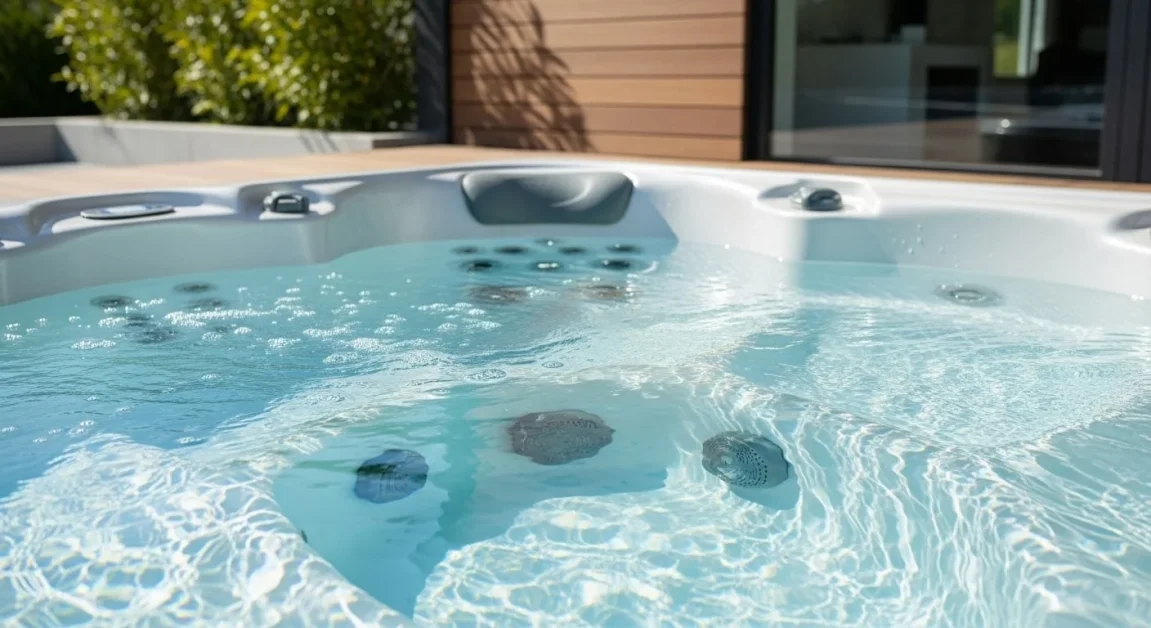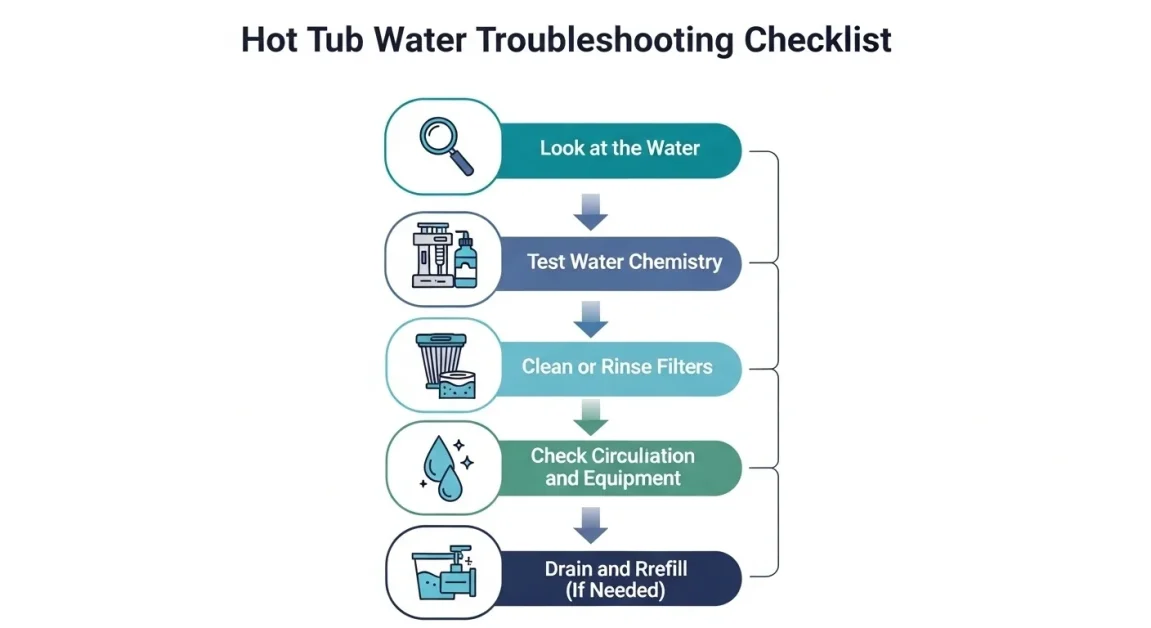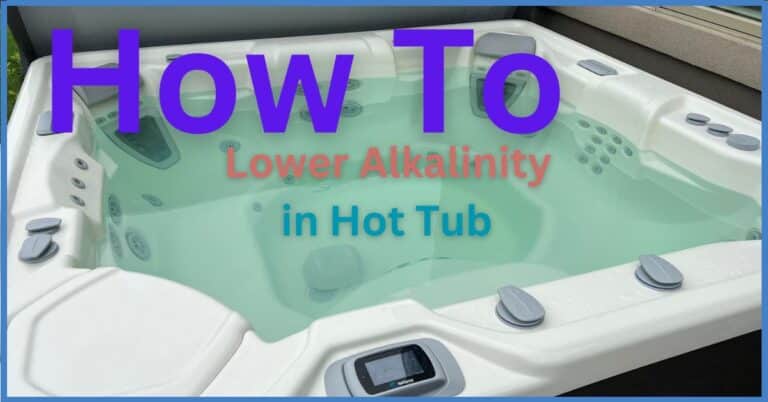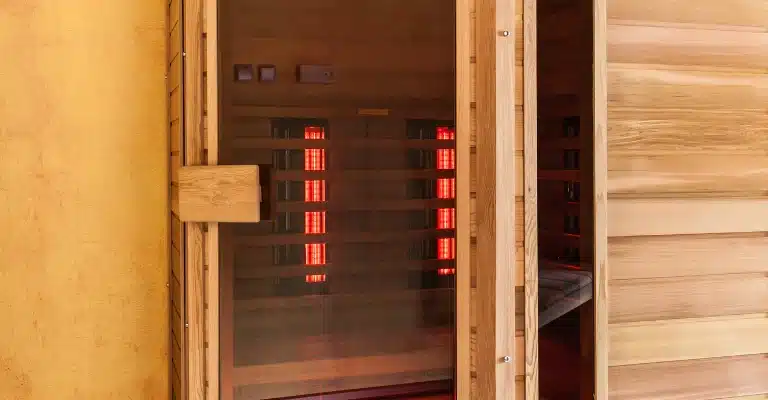9 Water Care Troubleshooting Issues To Fix
Hot tub water problems are common but easy to fix once you know the cause. Cloudy or smelly water usually means dirty filters, low sanitizer, or unbalanced pH.
Regularly test water, clean filters, and shock weekly. Address issues like algae, stains, or scale quickly to keep your spa safe, clear, and ready to use.
- 🔧 Spa Water Troubleshooting Guide
- Hot Tub Water Troubleshooting Checklist
- 9 Water Care Troubleshooting Issues To Fix
- Water Chemistry Cheat Sheet
- Maintenance Tips to Prevent Future Water Issues
- SPA WATER CARE
- Seasonal Spa Maintenance Cheat Sheet
- HOT TUB WATER CARE PRODUCTS
- Hot Tub Water Systems: An Overview
- Selecting the Right Hot Tub Water System
- FAQs

🔧 Spa Water Troubleshooting Guide
Quick fixes for common hot tub water issues
💡 Always test your water after making adjustments and consult your spa manual for specific instructions.
Check Hot Tub Water Care Guide
Hot Tub Water Troubleshooting Checklist

- Look at the Water
- Is it cloudy, foamy, green, or discolored?
- Take note of any strong odors (chlorine, musty, or foul).
- Test Water Chemistry
- Check pH, alkalinity, and sanitizer levels with test strips.
- Compare to the ideal ranges (pH 7.2–7.6, sanitizer 3–5 ppm).
- Adjust Chemicals
- If pH or alkalinity are off, use pH/alkalinity up or down.
- Add sanitizer if chlorine or bromine is low.
- Clean or Rinse Filters
- Remove filters, rinse with hose, or use a filter cleaner.
- Dirty filters are the number one cause of cloudy water.
- Shock the Spa
- Add a chlorine or non-chlorine shock to break down organics.
- Run jets for 15–20 minutes to circulate.
- Check Circulation and Equipment
- Make sure pumps and jets are running properly.
- Look for clogs or reduced water flow.
- Drain and Refill (If Needed)
- If water is still cloudy, foamy, or smelly after treatment, drain, scrub, and refill with fresh water.
9 Water Care Troubleshooting Issues To Fix
1. Cloudy Water
Probable Causes:
- Dirty Filters: Filters that have accumulated dirt and debris can hinder water flow and filtration.
- Excessive Oils or Organic Matter: Lotions, body oils, and other organic materials can cloud the water.
- Improper Sanitizing: Insufficient sanitizer levels can allow bacteria and algae to thrive.
- Suspended Particles or Organic Matter: These can result from inadequate filtration or organic waste.
- Overused or Old Water: Water that hasn’t been changed in a while can accumulate impurities.
Solutions:
- Clean Filters: Use FreshWater Instant Filter Cleaner or FreshWater Filter Cleaner to clean your filters thoroughly.
- Shock the Spa: Add a shock treatment of sanitizer to oxidize and eliminate organic matter.
- Add Sanitizer: Ensure the sanitizer levels are adequate. Follow the manufacturer’s recommended dosage.
- Adjust pH and Alkalinity: Use FreshWater pH/Alkalinity Up or FreshWater Alkalinity Down to bring levels within the recommended range.
- Run Jet Pumps: Operate the jet pumps to circulate the water and help filter out suspended particles.
- Drain and Refill: If the water is old, drain the spa, clean the surfaces, and refill with fresh water.
Check Our Guide To Cloudy Hot Tub Water

2. Water Odor
Probable Causes:
- Excessive Organics in Water: Accumulated organic matter can cause unpleasant odors.
- Improper Sanitization: Insufficient sanitization can allow bacteria to grow, leading to odors.
- Low pH: Water with a low pH can become more corrosive and odorous.
Solutions:
- Shock the Spa: Use a sanitizer to oxidize and remove organics.
- Add Sanitizer: Ensure sanitizer levels are adequate.
- Adjust pH: Use FreshWater pH/Alkalinity Up to increase the pH to the recommended range.
- Drain and Refill: If odors persist, drain, clean, and refill the spa.
3. Chlorine Odor
Probable Causes:
- High Chloramine Level: Chloramines, formed when chlorine binds with organic matter, can cause a strong chlorine smell.
- Low pH: A low pH can enhance the chlorine smell.
Solutions:
- Shock the Spa: Break down chloramines by adding a shock dose of sanitizer.
- Adjust pH: Use FreshWater pH/Alkalinity Up to bring the pH to the recommended level.
4. Musty Odor
Probable Cause:
- Bacteria or Algae Growth: These microorganisms can produce a musty smell.
Solutions:
- Shock the Spa: Use a sanitizer to kill bacteria and algae.
- Drain, Clean, and Refill: If the odor is persistent or visible, drain the spa, thoroughly clean all surfaces, and refill with fresh water.
5. Organic Buildup/Scum Ring Around Spa
Probable Cause: The buildup of Oils and Dirt: These can accumulate along the waterline, forming a scum ring.
Solutions:
- Wipe Off Scum: Use a clean rag to wipe off the buildup.
- Severe Cases: Drain the spa, clean with FreshWater Spa Shine, and refill.
Check out Dealing with White Particles in Hot Tub: Causes and Solutions.
6. Algae Growth
Probable Causes:
- High pH: Algae thrive in water with high pH levels.
- Low Sanitizer Level: Insufficient sanitizer allows algae to grow.
Solutions:
- Shock the Spa: Use a sanitizer to kill the algae.
- Adjust pH: Lower the pH to the recommended range using FreshWater pH/Alkalinity Down.
- Maintain Sanitizer Level: Keep sanitizer levels steady to prevent future growth.

7. Eye Irritation
Probable Causes:
- Low pH: Acidic water can cause eye irritation.
- Low Sanitizer Level: Insufficient sanitizer can lead to bacterial growth and irritation of the eyes.
Solutions:
- Adjust pH: Raise the pH using FreshWater pH/Alkalinity Up.
- Shock the Spa: Use sanitizer and ensure it stays at the proper level.
Skin Irritation/Rash
Probable Causes:
- Unsanitary Water: Lack of proper sanitization can lead to skin irritation.
- High Chlorine Level: Free chlorine levels above 5 ppm can irritate the skin.
Solutions:
- Shock the Spa: Use sanitizer and maintain it at recommended levels.
- Allow Chlorine to Drop: Ensure free chlorine levels drop below 5 ppm before using the spa.
8. Stains
Probable Causes:
- Low Total Alkalinity and/or pH: This can cause metals to precipitate and stain surfaces.
- High Iron or Copper in Source Water: These metals can leave stains.
Solutions:
- Adjust Alkalinity and pH: Use FreshWater pH/Alkalinity Up to the correct levels.
- Use FreshWater Stain & Scale: This product helps inhibit metal stains.
9. Scale
Probable Causes:
- High Total Alkalinity and/or pH: High levels can cause calcium to precipitate as scale.
- High Calcium Content in Water: Excess calcium can lead to scale formation.
Solutions:
- Adjust Alkalinity and pH: Lower levels using FreshWater pH/Alkalinity Down.
- Remove Scale: If needed, drain the spa, scrub off the scale, clean with FreshWater Spa Shine, and refill.
- Prevent Future Scale: Use FreshWater Stain & Scale and maintain balanced water chemistry with FreshWater pH/Alkalinity Up or Down.
Water Chemistry Cheat Sheet
| Water Parameter | Ideal Range | Why It Matters | Quick Fix if Out of Range |
|---|---|---|---|
| pH | 7.2 – 7.6 | Keeps water comfortable, prevents corrosion or scale | Use pH Up or Down to adjust |
| Total Alkalinity | 80 – 120 ppm | Stabilizes pH and keeps it from swinging | Use Alkalinity Increaser or pH Decreaser |
| Calcium Hardness | 150 – 250 ppm | Protects spa surfaces and equipment from corrosion | Add Calcium Hardness Increaser or dilute with fresh water |
| Chlorine (if used) | 3 – 5 ppm | Sanitizes water and kills bacteria | Add chlorine granules or shock if low |
| Bromine (if used) | 3 – 5 ppm | Works well in hot water, low odor option | Add bromine tablets or shock if low |
Maintenance Tips to Prevent Future Water Issues
To maintain consistent water quality, follow these best practices:
- Regular Testing: Test the water 2-3 times a week to monitor pH, sanitizer levels, and calcium hardness.
- Sanitize Consistently: Keep chlorine or bromine levels within recommended ranges to prevent bacteria growth.
- Shock Weekly: Oxidize contaminants and remove chloramines with a regular shock treatment.
- Clean Filters Monthly: Rinse or replace filters to keep water circulating effectively.
- Drain and Refill Every 3-4 Months: Fresh water helps prevent TDS accumulation and ensures a clean environment.
SPA WATER CARE
Maintaining a consistent spa water care routine ensures that you’ll always have crystal-clear water, minimizing downtime and the need for complex repairs. Routine maintenance also helps extend the life of your spa equipment.

1. Water Balance Essentials
- pH Levels: Keep pH between 7.2 and 7.6 to prevent scaling and irritation. Low pH can corrode spa components, while high pH reduces sanitizer effectiveness.
- Alkalinity: Maintain total alkalinity between 80-120 ppm to stabilize pH levels.
- Calcium Hardness: Soft water leads to corrosion, while high calcium levels can cause scale buildup. Aim for calcium hardness between 150-250 ppm.
2. Filtration and Circulation
Proper water circulation is crucial for preventing stagnant water, which can harbor bacteria and contaminants. Run your spa’s filtration system daily according to manufacturer recommendations.
- Clean Filters Regularly: Rinse filters monthly and replace them every 12-18 months.
- Filter Cleaning Solution: Use dedicated filter cleaning products to break down oils and debris.
3. Sanitization and Shocking
- Sanitizers (Chlorine or Bromine): Chlorine or bromine keeps the water free from harmful bacteria.
- Shock Treatment: Weekly shocking oxidizes contaminants and breaks down chloramines or bromamines. Use non-chlorine shock if you prefer less harsh chemicals.
4. Preventing Biofilm and Scaling
- Biofilm Cleaners: Regular use of spa system flushes prevents biofilm buildup in plumbing lines.
- Scale Control Products: If you have hard water, use scale inhibitors to prevent calcium deposits.
Best Hot Tub Monitoring System
Seasonal Spa Maintenance Cheat Sheet
| Season | Key Tasks | Why It Matters |
|---|---|---|
| Spring | Deep clean spa shell, flush plumbing lines, replace filters if needed, check cover for damage | Gets your spa ready after winter, removes biofilm buildup, and ensures equipment is in good shape |
| Summer | Test water 2–3 times per week, shock after heavy use, keep cover on to reduce evaporation | Hot weather can throw off chemical balance and cause faster evaporation |
| Fall | Drain and refill before cold weather, balance water chemistry, inspect heater and pump | Fresh water reduces TDS, and early prep keeps your spa running smoothly through winter |
| Winter | Keep water circulating to prevent freezing, monitor water level, test chemicals weekly | Prevents damage from freezing temps and keeps water safe for use year-round |
HOT TUB WATER CARE PRODUCTS
Using the right combination of hot tub water care products will ensure your spa stays clean, clear, and balanced.
Always follow manufacturer recommendations for dosage and application frequency to maintain optimal water quality and prolong the life of your hot tub equipment.

1. Sanitizers
Sanitizers are essential for killing bacteria and keeping the water safe.
- Chlorine: Fast-acting and effective, chlorine is a popular choice for many hot tub owners.
- Bromine: Bromine works better in high temperatures and has lower odor levels compared to chlorine.
2. Shock Treatments
Shock treatments oxidize contaminants and restore water clarity.
- Chlorine-Based Shock: A powerful option for deep cleaning.
- Non-Chlorine Shock: Suitable for routine maintenance without adding more chlorine.
3. Water Balancers
These products help maintain proper pH, alkalinity, and calcium levels.
- pH Increaser / Reducer: Adjusts the pH to the ideal range of 7.2–7.6.
- Alkalinity Increaser: Prevents pH fluctuations.
- Calcium Hardness Increaser: Prevents corrosion and protects spa components.
4. Clarifiers and Foam Reducers
- Water Clarifier: Binds small particles together, making it easier for the filter to capture them.
- Defoamers: Quickly removes foam caused by lotions, oils, and detergents.
5. Metal and Scale Control
- Metal Sequestrants: Prevent staining and discoloration from metals like iron or copper.
- Scale Inhibitors: Reduces calcium buildup, preventing scaling on spa surfaces and equipment.
6. Filter Cleaning Products
Filters play a critical role in maintaining water clarity, and regular cleaning is essential.
- Filter Cleaner: Removes oils, debris, and contaminants from the filter.
- Instant Filter Sprays: Convenient for quick cleanings between deep washes.
7. Specialty Products
- Aromatherapy Additives: Enhance your spa experience with soothing scents that won’t affect water chemistry.
- Enzymatic Cleaners: Help break down oils and organic matter in the water, reducing the strain on the sanitizer.
Hot Tub Water Systems: An Overview
Hot tub water systems play a crucial role in maintaining water cleanliness, chemical balance, and overall user comfort. Below is a detailed of the most common water systems to help you understand their benefits and requirements.
1. Chlorine-Based Water Systems
Chlorine is a powerful sanitizer that kills bacteria, viruses, and algae in the water. It comes in granules or tablets and is widely used in both pools and hot tubs.
Pros:
Cons:
2. Bromine Water Systems
Bromine works similarly to chlorine but remains stable at high temperatures, making it an excellent choice for hot tubs. It can also be used in tablet or granule form.
Pros:
- Less odor compared to chlorine.
- Works effectively at higher temperatures.
- Produces fewer skin and eye irritants.
Cons:
- More expensive than chlorine.
- Can take longer to dissolve and act.
- Requires additional oxidizers for optimal performance.
3. Saltwater Systems
Saltwater systems use a salt chlorine generator to convert salt into chlorine through electrolysis, providing continuous sanitization. This method eliminates the need to add chlorine manually.
Pros:
- Softer water that is gentler on skin and eyes.
- Minimal chemical maintenance required.
- Produces less odor compared to traditional chlorine.
Cons:
- Higher initial cost for the saltwater system.
- Requires monitoring of salt and chlorine levels.
- Can corrode hot tub components if not properly managed.
4. Ozone Water Systems (Ozonators)
Ozone water systems inject ozone gas into the water, which destroys bacteria and contaminants. Ozone acts as a powerful oxidizer, reducing the need for chemical sanitizers.
Pros:
- Reduces the amount of chlorine or bromine needed.
- Provides superior water clarity.
- Eco-friendly, as ozone breaks down into oxygen.
Cons:
- Requires additional sanitizers for complete disinfection.
- Ozonator units need replacement over time.
- Higher initial setup cost.
5. UV-C Water Systems
Use ultraviolet light to disinfect water by disrupting the DNA of bacteria, viruses, and other microorganisms. This system provides chemical-free sterilization.
Pros:
- Reduces the amount of chemicals needed.
- Provides clean water without odors or irritants.
- Eco-friendly and easy to maintain.
Cons:
- Does not provide residual disinfection, additional sanitizers are needed.
- UV bulbs need periodic replacement.
- Higher initial installation cost.
6. Mineral Water Systems
Natural minerals such as silver and copper into the water. These minerals inhibit bacterial growth and reduce the need for chlorine or bromine.
Pros:
- Gentle on skin and eyes.
- Reduces chemical use and odor.
- Easy to maintain with fewer chemical adjustments.
Cons:
- Requires periodic replacement of mineral cartridges.
- Additional sanitizers are still necessary.
- Higher ongoing costs for cartridges.
7. Enzymatic Water Systems
Use natural enzymes to break down organic contaminants like oils, lotions, and sweat, reducing the workload on sanitizers and filters.
Pros:
- Keeps water cleaner with less chemical use.
- Reduces scum lines and organic buildup.
- Minimizes foaming and cloudiness.
Cons:
- Works best as a complement to other sanitizers.
- Requires consistent use to be effective.
- Enzymes need to be replenished regularly.
Selecting the Right Hot Tub Water System
The right water system for your hot tub is key to ensuring a clean, safe, and enjoyable experience.
Consider these factors when deciding:
- Frequency of Use: For frequent hot tub users, saltwater or ozone systems provide greater convenience due to their automated sanitation processes.
- Skin Sensitivity: Mineral or bromine systems are gentler options, ideal for those with sensitive skin.
- Maintenance Preferences: Chlorine systems require regular monitoring and adjustments, while UV-C or saltwater systems offer low-maintenance alternatives.
- Budget: Evaluate both the initial installation costs and ongoing maintenance expenses to find a system that fits your financial plan.
FAQs
References
More information on hot tub water care and troubleshooting, please refer to the following sources:
- Water Care – Literature & Manuals: This page offers a comprehensive collection of manuals related to water care for hot tubs. You can find instructions and guidelines for maintaining optimal water quality. WaterCare.com












